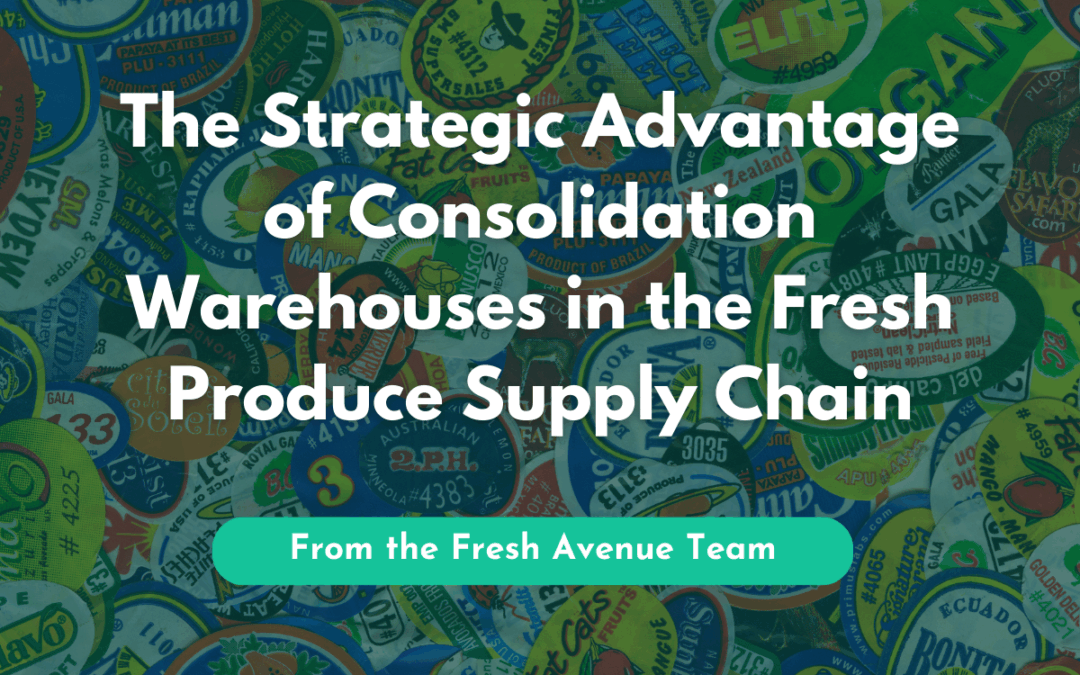In today’s fresh produce industry, efficiency isn’t just about cutting costs—it’s about ensuring speed, quality, and consistency from grower / processor to the customer. With tight margins, perishable products, and rising transportation costs, every link in the supply chain must operate at peak performance. One strategy that has transformed how produce moves across the country is the use of consolidation warehouses or hubs.
These facilities are not simply storage spaces. They serve as command centers that streamline logistics, expand access to product variety, and improve overall supply chain agility. For retailers, distributors, and foodservice operators, consolidation warehouses have become an essential strategy for staying competitive in a market that demands freshness, speed, and reliability.
What is the Advantage of Using a Consolidation Warehouse?
The key advantage of a consolidation warehouse lies in its ability to connect businesses to a nationwide shipping network and an expanded product selection—without the high costs of managing their own facility, team, and fleet.
Traditionally, companies that wanted to expand their distribution needed to invest heavily in infrastructure. That meant building warehouses, hiring staff, purchasing trucks, and managing a complex network of suppliers. For many, the costs were prohibitive, especially for smaller or mid-sized operations.
Consolidation warehouses eliminate these barriers. They bring together products from multiple growers and shippers under one roof, allowing businesses to source a wide variety of produce in one location. From there, shipments can be customized, combined, and sent out efficiently across the country.
This shared model offers three significant benefits:
- Cost Efficiency – By pooling resources, businesses avoid the capital burden of building and managing their own logistics infrastructure.
- Expanded Reach – Access to a nationwide distribution network allows companies to serve more markets quickly and consistently.
- Product Variety – A consolidation hub aggregates produce from different suppliers, giving buyers access to a broader selection without juggling multiple points of contact.
In short, consolidation warehouses give businesses the ability to scale nationally while staying lean operationally.
Services That Power Fresh Produce Consolidation
The real strength of a consolidation warehouse comes from the value-added services it provides beyond logistics. These services are designed specifically to handle the unique challenges of fresh produce—perishability, handling requirements, and the need for efficient delivery.
For example, Fresh Avenue’s consolidation hubs offer a comprehensive suite of services that optimize every stage of the supply chain:
- Repacking: Produce may need to be resized, re-labeled, or reconfigured for specific customers. Repacking ensures the product arrives in the right format for the end user.
- Case Pick/Pallet Builds: Orders are customized to maximize truck utilization. Instead of shipping half-empty trucks or excess pallets, consolidation hubs build orders strategically for efficiency.
- Order/Drop Sequencing: Deliveries are arranged in the exact sequence required, streamlining unloading at multiple stops and saving time at each delivery point.
- Direct Delivery: Products are delivered straight from the consolidation warehouse to the customer, shortening the supply chain and preserving freshness.
- Forward Distribution: By staging products closer to customers, businesses can cut lead times and respond quickly to demand shifts.
- Cross Dock: Instead of storing items, consolidation hubs can transfer goods from inbound to outbound trucks almost immediately, keeping product moving and minimizing storage time.
Each of these services reduces inefficiency, optimizes costs, and—most importantly—helps ensure produce arrives fresh and on time.
Why Consolidation Matters in the Fresh Produce Industry
The fresh produce supply chain is uniquely complex. Unlike packaged goods, fruits and vegetables are highly perishable, sensitive to temperature, and subject to unpredictable harvest cycles. At the same time, consumer demand for variety and year-round availability has never been higher.
Consolidation warehouses address these challenges head-on:
- They reduce touchpoints. Fewer stops and handoffs mean less risk of product damage or spoilage.
- They shorten timelines. Cross-docking and forward distribution move products faster from farm to table.
- They support flexibility. Retailers and foodservice operators can adjust orders more easily without being locked into rigid sourcing or delivery schedules.
- They improve sustainability. Optimized truckloads and reduced empty miles mean fewer emissions and lower fuel usage—a growing priority across the industry.
For businesses in fresh produce, consolidation is more than a cost-saving tactic. It’s a competitive advantage that supports growth, reliability, and customer satisfaction.
Building a Smarter Supply Chain
As the fresh produce market continues to evolve, supply chains must adapt to increasing demand, labor challenges, and rising transportation costs. Consolidation warehouses provide the agility needed to thrive in this environment. They allow companies to tap into nationwide networks, access a wide range of products, and leverage services that optimize every delivery.
For buyers, the payoff is clear: fresher produce, fewer headaches, and stronger profitability.
Consolidation hubs are reshaping how fresh produce moves across the country—making the supply chain smarter, faster, and more resilient.






